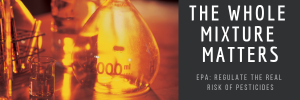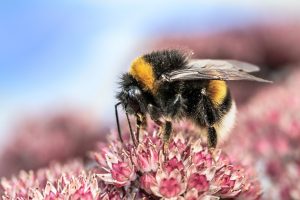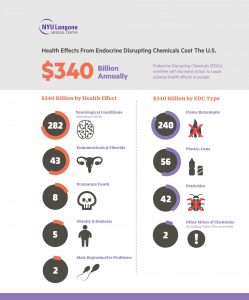26
Mar
Another Study Links Glyphosate to Cancer
 (Beyond Pesticides, March 26, 2019) In a study investigating the carcinogenic effects of pesticide exposure by analyzing data on 316,270 farmers and farmworkers in the U.S., Norway, and France, researchers have identified elevated risk for non Hodgkin lymphoma (NHL) and some subtypes, linking glyphosate and large B-cell lymphoma. Other pesticides linked to the disease include the pyrethroid deltamethrin and chronic lymphocytic leukemia/small lymphocytic lymphoma; and terbufos and NHL overall.
(Beyond Pesticides, March 26, 2019) In a study investigating the carcinogenic effects of pesticide exposure by analyzing data on 316,270 farmers and farmworkers in the U.S., Norway, and France, researchers have identified elevated risk for non Hodgkin lymphoma (NHL) and some subtypes, linking glyphosate and large B-cell lymphoma. Other pesticides linked to the disease include the pyrethroid deltamethrin and chronic lymphocytic leukemia/small lymphocytic lymphoma; and terbufos and NHL overall.
Researchers also found âinverse associations of NHL overall with the broader groups of organochlorine insecticides and phenoxy herbicides, after adjusting for exposure to other pesticidesâ; such inverse associations were not found with active ingredients within these groups. The research underscores how complex the science of pesticide impacts on human health, and on cancer incidence, can be. To wit: in evaluating 14 different pesticide categories and 33 individual, active chemical ingredients, Maria E. Leon, et al., conclude that associations of pesticides with the development of NHL appear to be (NHL) subtype- and chemical-specific.
Published in the International Journal of Epidemiology in mid-March, the study, âPesticide use and risk of non-Hodgkin lymphoid malignancies in agricultural cohorts from France, Norway and the USA: a pooled analysis from the AGRICOH consortium,â uses data from three large cohort groups in AGRICOH, âan international consortium of agricultural cohort studies formed in October of 2010 to encourage and support data pooling to study disease-exposure associations that individual cohorts do not have sufficient statistical power to study.â AGRICOH is a program of the World Health Organizationâs International Agency for Research on Cancer (IARC).
The three cohort groups included those from AGRICAN, a program of the Mutualité Sociale Agricole, the French national health insurance system of agricultural workers; CNAP, an aggregate group of farm holders and families compiled by Statistics Norway; and the Agricultural Health Study (AHS), which enrolled farmers and farm workers from Iowa and North Carolina.
Farmers and farmworkers are commonly exposed to a multitude of chemical compounds â especially pesticides (which term here includes herbicides and fungicides, as well) â through their work. Such activities can include: mixing and storing pesticide chemicals; applying them to seeds and/or fields; cleaning of related equipment; applications to livestock; and pest management in barns, soils, and animal compounds.
Notably, 75% of subjects in this study were male.
Each database exhibited linkages to cancer and mortality registries in their respective countries. Data were tracked for exposures to the subject pesticide (and other) compounds and the 33 active ingredients, and first incidence of cancer diagnoses. Subjects had no previous cancer diagnoses, except for an occasional non-melanoma skin cancer, before or during follow-up. The span of time frames for each study plus follow-up were as follows: AGRICAN, 2005â2009; CNAP, every five years from 1969 through 1989, with follow-up through 2011; and AHS, 1993â1997, with follow-up through 2010 in North Carolina, and 2011 in Iowa. Results of the study show that there were more than 2,400 cases of NHL across more than 3.5 million person-years of follow-up.
For this research, chemical groups and active ingredients were selected based on common use in at least two of the three countries. In addition, researchers gave priority to chemical groups and active ingredients for which some associative evidence with lympho-hematological malignancies has already been established, and to active ingredients not previously investigated in epidemiological studies. Glyphosate and dicamba were included in the study, as well as these categorical compounds: four insecticides (organophosphates, organochlorines, carbamates, and pyrethroids); seven herbicides (phenyl ureas, chloroacetanilides, dinitroanilines, phenoxys, thiocarbamates, triazines, and triazinones); two fungicides (dithiocarbamates and phthalimides); and arsenical compounds.
The ingredients (active, adjuvant, and âinertâ) in those pesticides represent a variety of chemical compounds, and exposures to one â or more â of them may have any number of mechanisms of action in the human body, per se or in combination. The investigators in this study note that âpesticide exposure can induce genotoxicity, immunosuppression, oxidative stress and/or inflammatory effects, hormone receptor modulation and/or other biological responses that are important characteristics of carcinogens.â They make the case that because of this plethora of factors, individual active ingredients should be researched, as well as categories of pesticides.
The territory for research on pesticidesâ potential carcinogenicity, and other impacts on human health, is almost ridiculously complicated. Yet there is some convergence across research that exposure to certain pesticides increases the risk of developing some cancers. The association that has been in a blinding spotlight for the past few years is that between exposures to glyphosate and/or glyphosate-based herbicides and risks of developing non-Hodgkinâs Lymphoma, in particular. Beyond Pesticides has covered the mounting evidence of the dangers of glyphosate; most recently, it reviewed a meta-study that suggests a compelling link between exposures to glyphosate-based herbicides and increased risk of NHL.
In addition, it has written extensively on developments in the science and regulatory arena, including:
- the IARCâs 2015 landmark designation of glyphosate as potentially carcinogenic
- evidence that the Environmental Protection Agency colluded with Monsanto (maker of Roundup, the most widely used glyphosate-based herbicide) to advantage industry, and that Monsanto had actually ghostwritten research that countered scientific conclusions on the cancer associations of the compound
- Californiaâs 2017 listing of glyphosate under Proposition 65 as a probable carcinogen and a 2018 Appellate Court affirmation of its ability to do so
Beyond Pesticides has also tracked the falling dominoes in the glyphosate drama that is currently unfolding in the courts. In the summer of 2018, California groundskeeper Dewayne Johnson won a $289 million jury verdict against Monsanto for his development of NHL after consistent exposure to Roundup. The jury awarded him $39 million in compensatory damages, and $250 million in punitive damages, finding that Monsanto acted with âmalice or oppression.â That amount was later amended by the judge to a total $78 million. Most recently, in another court case, again in California, the jury found unanimously that Edwin Hardemanâs development of NHL was substantially caused by Roundup; the case moves next to award of damages to the plaintiff. On the commercial front, insurers are beginning to balk at the liability inherent in use of these herbicides; beyond these two cases, another 8,000+ glyphosate-based suits against manufacturers, sellers, and users are in queue. In addition, localities are taking steps to protect the health of residents by reining in the use of glyphosate, as has happened recently in Montgomery County, Maryland, and Miami, Florida.
Industry will not back down easily, making it critical that voices across all sectors speak out for increased regulation of these compounds, at the very least. With all the increased attention on glyphosate and its risks, there is more reason than ever to advocate for its elimination and the advent of less toxic alternatives. Beyond Pesticides is ready to help with organizing communities; contact us. We also urge those concerned about glyphosate exposure to support organic systems that do not rely on hazardous, carcinogenic pesticides. To learn about all the reasons to âgo organicâ and advocate for organic integrity, see Eating with a Conscience and Keeping Organic Strong.
It is possible that the use of glyphosate is approaching a tipping point, beyond which recognition of its dangers may result in greater public demand for regulation thatâs protective, and withdrawal of the products from the marketplace. Beyond Pesticides remains determined to advance the cause of human and environmental health, and looks forward eagerly to that tipping point.
All unattributed positions and opinions in this piece are those of Beyond Pesticides.
Source: https://academic.oup.com/ije/advance-article/doi/10.1093/ije/dyz017/5382278









 (Beyond Pesticides, March 25, 2019)Â EPA is using a regulatory loophole â the âtreated articles exemptionâ â to allow systemic insecticides to be used in mass quantities, without regulating or labeling them as required under the Federal Insecticide, Fungicide and Rodenticide Act (FIFRA). EPA does not currently assess adverse effects on the environment and public health caused by widespread use of neonicotinoid insecticides delivered through seeds coated with the insecticides, resulting in widespread exposure to one of the most environmentally damaging classes of chemicals on the market.
(Beyond Pesticides, March 25, 2019)Â EPA is using a regulatory loophole â the âtreated articles exemptionâ â to allow systemic insecticides to be used in mass quantities, without regulating or labeling them as required under the Federal Insecticide, Fungicide and Rodenticide Act (FIFRA). EPA does not currently assess adverse effects on the environment and public health caused by widespread use of neonicotinoid insecticides delivered through seeds coated with the insecticides, resulting in widespread exposure to one of the most environmentally damaging classes of chemicals on the market. (Beyond Pesticides, March 22, 2019) A
(Beyond Pesticides, March 22, 2019) A  (Beyond Pesticides, March 21, 2019) Corporate food giant General Mills has thrown some weight behind regenerative agriculture, committing to converting one million acres of farmland to regenerative practices by 2030. Some – but not all – of the initiative involves organic land management.
(Beyond Pesticides, March 21, 2019) Corporate food giant General Mills has thrown some weight behind regenerative agriculture, committing to converting one million acres of farmland to regenerative practices by 2030. Some – but not all – of the initiative involves organic land management. (Beyond Pesticides, March 20, 2019)Â In a second verdict against Bayer/Monsanto yesterday, a jury found unanimously that a California manâs non Hodgkin lymphoma (NHL) was substantially caused by the herbicide glyphosate (Roundup). The case being heard in federal court in San Francisco now moves to the damages phase. Last August in
(Beyond Pesticides, March 20, 2019)Â In a second verdict against Bayer/Monsanto yesterday, a jury found unanimously that a California manâs non Hodgkin lymphoma (NHL) was substantially caused by the herbicide glyphosate (Roundup). The case being heard in federal court in San Francisco now moves to the damages phase. Last August in  (Beyond Pesticides, March 19, 2019) Research is beginning to explain how systemic neonicotinoid insecticides affect often overlooked species of ground nesting bees. While much of the current scientific literature has focused on the impacts of pesticides to bumblebees and honey bees, a study,Â
(Beyond Pesticides, March 19, 2019) Research is beginning to explain how systemic neonicotinoid insecticides affect often overlooked species of ground nesting bees. While much of the current scientific literature has focused on the impacts of pesticides to bumblebees and honey bees, a study, 
 (Beyond Pesticides, March 14, 2019) A
(Beyond Pesticides, March 14, 2019) A  (Beyond Pesticides, March 13, 2019) A study on the impact of two neonicotinoid pesticides shows differential gene expression in bumblebees (Bombus terrestris) after exposure. Considering the current
(Beyond Pesticides, March 13, 2019) A study on the impact of two neonicotinoid pesticides shows differential gene expression in bumblebees (Bombus terrestris) after exposure. Considering the current  (Beyond Pesticides, March 12, 2019) Fifty years after the end of the Vietnam War, the Agent Orange byproduct dioxin continues to contaminate Vietnamâs soils and wildlife, and subsequently affect human health. InÂ
(Beyond Pesticides, March 12, 2019) Fifty years after the end of the Vietnam War, the Agent Orange byproduct dioxin continues to contaminate Vietnamâs soils and wildlife, and subsequently affect human health. In  (Beyond Pesticides, March 11, 2019)  We must stop the expanded commercialization of genetically engineered pesticides. The failure of the U.S. Environmental Protection Agency (EPA) to fully evaluate environmental impacts of gene-manipulating pesticides raises serious concerns in light of the agencyâs ongoing failure to predict ecological effects of pesticides, such as the dramatic decline of pollinators.
(Beyond Pesticides, March 11, 2019)Â Â We must stop the expanded commercialization of genetically engineered pesticides. The failure of the U.S. Environmental Protection Agency (EPA) to fully evaluate environmental impacts of gene-manipulating pesticides raises serious concerns in light of the agencyâs ongoing failure to predict ecological effects of pesticides, such as the dramatic decline of pollinators. (Beyond Pesticides, March 8, 2019)Â Researchers from the U.S. and Switzerland have
(Beyond Pesticides, March 8, 2019)Â Researchers from the U.S. and Switzerland have  (Beyond Pesticides, March 7, 2019) A
(Beyond Pesticides, March 7, 2019) A  (Beyond Pesticides, March 6, 2019) After a brief hiatus, Florida Fish and Wildlife Conservation Commission (FWC) is continuing use of aquatic herbicides, including glyphosate, for invasive species management. Public pressure and feedback caused FWC to take a
(Beyond Pesticides, March 6, 2019) After a brief hiatus, Florida Fish and Wildlife Conservation Commission (FWC) is continuing use of aquatic herbicides, including glyphosate, for invasive species management. Public pressure and feedback caused FWC to take a  (Beyond Pesticides, March 5, 2019) Wild, edible plants subject to drift from the herbicide glyphosate during forestry operations can be contaminated with the chemical an entire year after an initial application, according to a
(Beyond Pesticides, March 5, 2019) Wild, edible plants subject to drift from the herbicide glyphosate during forestry operations can be contaminated with the chemical an entire year after an initial application, according to a  (Beyond Pesticides, March 4, 2019) Last week, U.S. Representative Earl Blumenauer (D-OR) reintroduced the
(Beyond Pesticides, March 4, 2019) Last week, U.S. Representative Earl Blumenauer (D-OR) reintroduced the  (Beyond Pesticides, March 1, 2019)Â The costs of pesticide use extend far beyond the invoices farmers pay for purchase of the chemicals to use on their crops. The real costs related to pesticide use and exposure include those of health care, lost productivity and income, and environmental damage (loss of environmental services and biodiversity; compromised air, water, and soil quality). There has been relatively little research focused on those real and extensive costs; this
(Beyond Pesticides, March 1, 2019)Â The costs of pesticide use extend far beyond the invoices farmers pay for purchase of the chemicals to use on their crops. The real costs related to pesticide use and exposure include those of health care, lost productivity and income, and environmental damage (loss of environmental services and biodiversity; compromised air, water, and soil quality). There has been relatively little research focused on those real and extensive costs; this  (Beyond Pesticides, February 27, 2019) U.S. PIRG tested 20 common beers and wines and found glyphosate residues in all but one. Glyphosate, the active ingredient in Roundup, is the most commonly used agrichemical in the world. Though it is linked to many health and environmental issues, there is no current EPA limit for glyphosate residues in beer or wine. The U.S. Department of Agriculture (USDA) does not regularly test for glyphosate on either food or beverages.
(Beyond Pesticides, February 27, 2019) U.S. PIRG tested 20 common beers and wines and found glyphosate residues in all but one. Glyphosate, the active ingredient in Roundup, is the most commonly used agrichemical in the world. Though it is linked to many health and environmental issues, there is no current EPA limit for glyphosate residues in beer or wine. The U.S. Department of Agriculture (USDA) does not regularly test for glyphosate on either food or beverages. (Beyond Pesticides, February 26, 2019) Breakfast cereal, apples, applesauce and pinto beans made and sold by Kroger contain residues of toxic pesticides linked to a range of series health and environmental problems, according to a
(Beyond Pesticides, February 26, 2019) Breakfast cereal, apples, applesauce and pinto beans made and sold by Kroger contain residues of toxic pesticides linked to a range of series health and environmental problems, according to a  (Beyond Pesticides, February 22, 2019) Lake Erie, the 11th largest freshwater lake in the world, is once again plagued with pollution, although in this decade it is due primarily to agricultural runoff â as opposed to the raw sewage and industrial effluents that afflicted it in the mid-20th century. Concerned and weary Toledo, Ohio residents are seeking remedies through the adoption of a
(Beyond Pesticides, February 22, 2019)Â Lake Erie, the 11th largest freshwater lake in the world, is once again plagued with pollution, although in this decade it is due primarily to agricultural runoff â as opposed to the raw sewage and industrial effluents that afflicted it in the mid-20th century. Concerned and weary Toledo, Ohio residents are seeking remedies through the adoption of a 
